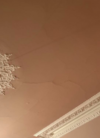- Joined
- 29 Apr 2024
- Messages
- 3
- Reaction score
- 0
- Country

Hi, just looking for some advice...
There are some cracks on the celing in a Victorian flat we've just bought and we're working out what to do. I was wondering if someone could help? We've had a few different quotes and have been told different things, so not quite sure what to do.
Just looking to the celing, we probably wouldn't have thought to do anything, however the surveyor said the plaster has been debonded from the timber lath substrate and will require significant replastering over the years.
We've been told we could put joint tape where needed and repair the crack to having to completely take down the whole celing and redo it, so not too sure what we shoud do.
My main worry it how dangerous it would be to just repair the crack, is it possible the whole ceiling would just fall down?
Money is an issue at the moment so also don't want to pay to have the whole celing redone if it doesn't really need to.
Any advice would be great, thanks!
There are some cracks on the celing in a Victorian flat we've just bought and we're working out what to do. I was wondering if someone could help? We've had a few different quotes and have been told different things, so not quite sure what to do.
Just looking to the celing, we probably wouldn't have thought to do anything, however the surveyor said the plaster has been debonded from the timber lath substrate and will require significant replastering over the years.
We've been told we could put joint tape where needed and repair the crack to having to completely take down the whole celing and redo it, so not too sure what we shoud do.
My main worry it how dangerous it would be to just repair the crack, is it possible the whole ceiling would just fall down?
Money is an issue at the moment so also don't want to pay to have the whole celing redone if it doesn't really need to.
Any advice would be great, thanks!


